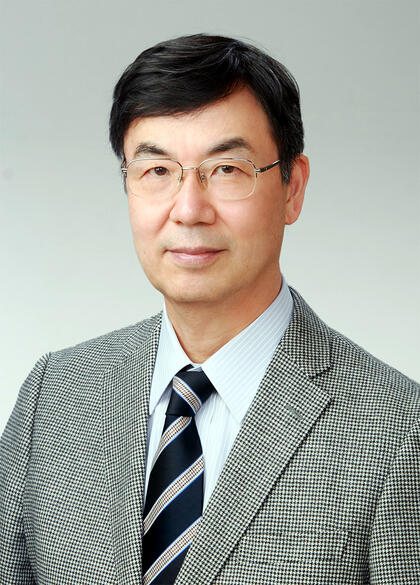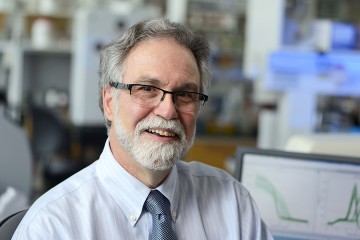- Name
- Jill Rosen
- jrosen@jhu.edu
- Office phone
- 443-997-9906
- Cell phone
- 443-547-8805
Shimon Sakaguchi, one of three scientists to receive the Nobel Prize in medicine on Monday for discoveries related to the human immune system, performed postdoctoral studies in both the Department of Immunology and Infectious Diseases and the Department of Biophysics at Johns Hopkins in the 1980s.

Image caption: Shimon Sakaguchi
Sakaguchi, now a distinguished professor at Osaka University's Immunology Frontier Research Center in Japan, was recognized along with Mary E. Brunkow of the Institute for Systems Biology in Seattle and Fred Ramsdell of Sonoma Biotherapeutics in San Francisco "for their discoveries concerning peripheral immune tolerance," the Nobel committee said in announcing the award early Monday.
Sakaguchi, Brunkow, and Ramsdell are credited with identifying the critical role regulatory T cells play in preventing immune cells from attacking our own body. Their discoveries laid the foundation for a new field of research, peripheral tolerance, and have led to the development of potential treatments for autoimmune diseases and cancer, several of which are now being evaluated in clinical trials.
"The immune system is a complicated system that requires a lot of checks and balances, but an immune system that is unregulated is an immune system gone awry," said Johns Hopkins School of Medicine professor Jonathan Schneck, a leader in the fields of cellular immunology and immunoengineering whose research focuses on T cell immunology. "So what we need is not just the native immune response, but a way of controlling it and making sure the response is directed to a foreign invader.
"We had knowns certain elements of that control before this current work, but we really didn't know the full nature of the control of the immune response. It's really very critical that we understand all the control mechanisms and all the things that regulatory T cells can do to prevent us from attacking our own body."
Schneck added that the work of Sakaguchi, Brunkow, and Ramsdell was "very seminal and fundamental" to the field of immunology, paving the way for promising treatments for autoimmune diseases including lupus, diabetes, and arthritis, as well as for cancer immunotherapy.
"We stand on the shoulders of these giants in thinking about, can we harness the information that they have given us to help develop better treatments," he said.
More from the Nobel committee's news release:
Shimon Sakaguchi was swimming against the tide in 1995, when he made the first key discovery. At the time, many researchers were convinced that immune tolerance only developed due to potentially harmful immune cells being eliminated in the thymus, through a process called central tolerance. Sakaguchi showed that the immune system is more complex and discovered a previously unknown class of immune cells, which protect the body from autoimmune diseases.
Mary Brunkow and Fred Ramsdell made the other key discovery in 2001, when they presented the explanation for why a specific mouse strain was particularly vulnerable to autoimmune diseases. They had discovered that the mice have a mutation in a gene that they named Foxp3. They also showed that mutations in the human equivalent of this gene cause a serious autoimmune disease, IPEX.
Two years after this, Shimon Sakaguchi was able to link these discoveries. He proved that the Foxp3 gene governs the development of the cells he identified in 1995. These cells, now known as regulatory T cells, monitor other immune cells and ensure that our immune system tolerates our own tissues.
Sakaguchi earned an MD and a PhD from Kyoto University in Japan, where he was trained as a pathologist and immunologist. He then participated in postdoctoral studies at both Johns Hopkins and Stanford University from 1983 to 1987 as a Lucille P. Markey Scholar, a position supported by a charitable trust devoted to supporting basic biomedical research at U.S. institutions.
His work at Hopkins reflects early work on regulatory T cells and their function in the immune system. In March 1985, he co-authored an abstract in the journal Federation Proceedings titled "Organ-specific autoimmune disease induced in mice: Ontogenic differences of regulatory T cells and effector T cells." Sakaguchi's co-authors on that article were Noriko Sakagushi, his wife and longtime collaborator, and Noel R. Rose, a longtime Johns Hopkins Bloomberg School of Public Health faculty member and researcher widely recognized as a father of autoimmune disease research. Rose, who died in 2020, chaired the Department of Immunology and Infectious Diseases—now called the Department of Molecular Microbiology and Immunology—from 1982 to 1993.
Sakaguchi's work at Johns Hopkins also included time in the Department of Biophysics and Biophysical Chemistry with biophysicists Howard and Renee Dintzis, who pioneered discoveries in how cellular proteins are constructed. At that time, the Dintzises were also working in the immunology field to understand the underlying mechanism by which immune responses were triggered, and other fundamental aspects of immunology.
Hopkins immunologist Mark Soloski, a professor emeritus of medicine, recalls working in his lab a floor above Shimon and Noriko Sakaguchi in the Wood Basic Science Building on the East Baltimore campus. "They were hardworking scientists, and initially I didn't understand the full implications of their research," Soloski said. "Then I got it and ever since then, my lectures on regulatory T cells have always included their seminal work and connection with Johns Hopkins."
Sakaguchi went on to serve as an assistant professor in the Department of Immunology at the Scripps Research Institute before returning to Japan in 1991.
Correction: An earlier version of this article contained incorrect information about a March 1985 publication in Federation Proceedings. The Hub regrets the error.
Posted in Health, Science+Technology








